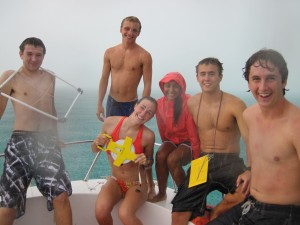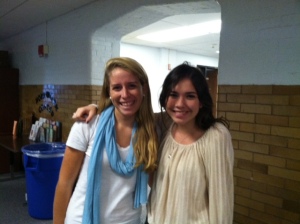 An aquamarine ocean, stretching from the shallowest of waters to the deepest of abyss may be a lonely place; at times nothing but stretches of white sand and swaying sea grass is found upon the seafloor. Following a yellowtail snapper though, one may find themselves floating over a bustling patch reef. What is a patch reef you may ask? Located in shallow waters, these isolated coral reef outcrops, with an array of brightly colored fish and slow moving invertebrates; provide an essential transitional habitat for juvenile fish still unequipped for the strains of the open ocean. Continue reading
An aquamarine ocean, stretching from the shallowest of waters to the deepest of abyss may be a lonely place; at times nothing but stretches of white sand and swaying sea grass is found upon the seafloor. Following a yellowtail snapper though, one may find themselves floating over a bustling patch reef. What is a patch reef you may ask? Located in shallow waters, these isolated coral reef outcrops, with an array of brightly colored fish and slow moving invertebrates; provide an essential transitional habitat for juvenile fish still unequipped for the strains of the open ocean. Continue reading
Yearly Archives: 2011
Eleutheros
This year, the Human Ecology, Histories, and Literature Departments have collaborated on a series ongoing assignments. Each week students are asked to write a reflective essay that demonstrates their understanding of the themes from their coursework and effectively links these themes to their unique thoughts and experiences. Enjoy reading how our students have deeply and personally engage with essential questions, important to their course of study at The Island School…
This Weeks Prompt: How does culture affect one’s relationship with the ocean?
“The Glue that Holds Us Together” by Helen Russell
My first memory is at the beach. I was four years old at Bethany Beach, Maryland with my dad’s side of the family and I was playing in the waves with my grandpa. It was the first year that my brother was with us, having been born the previous winter and everyone was obsessed with the baby. Like a typical four-year-old with a new baby in the family, I was feeling pretty neglected. But that day my grandpa had said that he wanted to go to the beach just me and him, to have “grandpa, granddaughter” time. So we make our way to the beach, me with my floaties around my arms and my towel dragging behind me. The only way that I remember all these details is because of pictures I have of myself that summer. So we played in the waves and for the first time in my life, I wondered when the ocean ended. So I asked my grandpa how the blue went on forever and he said that it was like glue that held all the continents together. He said that they were so far apart that the glue had to stretch over the sides of the Earth and that if I could swim all the way out to the horizon, then I could see the next continent. So that was my first definition of the Ocean: the glue that held the continents together. Continue reading
Weekly Lionfish Research Update
by Lincoln Zweig and John Morris
[slideshow]
This was a very successful week for the lionfish research team. On Tuesday we had two great reading note presentations and started to work on our first group project. By our next class on Friday we had a PowerPoint set up that described our research group’s purpose. After a practice presentation we went out into the field. Each buddy team finished three transects at the first dive spot that went very well. However, the reef was quite flat so we didn’t see too many lionfish or grouper. A bolt of lightening then interrupted our dive, and we headed back to The Island School. Apparently the weather gods don’t like it when we dive on Friday. Saturday was an almost flawless day in the field. We got to both of our desired dive sites and had very well set up transects at each one. We saw more lionfish and grouper on Saturday because the reefs we visited had more ledges for lionfish to use as shelter. As a group we are definitely ready and excited for our presentation on Tuesday!
Cacique Update October 9, 2011
by Caciques Ellen and Zeke
Zeke:
During exploration time today, the waters at High Rock and Fourth Hole were a little less than nice to those of us who decided to take snorkeling trips there. Before brunch, a group of us from the boys’ dorm went to high rock for a snorkel. After being tossed around by the waves for a few minutes, we were soon chased out by the lighting we saw offshore and biked back to school, a little disappointed.
After brunch Erik Canfield and I took a trip to Fourth Hole to see if the octopus we had spotted earlier was still in his den. We couldn’t even find the den, and great deal of our time braving yet more waves that were trying to “turn us into chowder.” We didn’t see too much there, due to the water’s murkiness, so we headed back to school to try our luck at Boy’s Dorm Beach. The water was much calmer there, enabling me to get some great photos with my SeaLife camera. [slideshow]
On this trip, we came across a yellow stingray that appeared to be trapped in a fisherman’s cage. Continue reading
Cacique Update October 7, 2011
by Cacique Claire
The day started off with Bizarro tracks. So the students who usually swim, ran and the runners swam. The runners took on the challenge of swimming up the current towards the bridge by the Marina quarter mile down the road from school, while the swimmers ran the four mile inner loop. After breakfast and chores we all had math, then history class. In math we had a Harkness discussion on new possible ways to rotate which cisterns we pull from in order to conserve more water. In History we continued our discussion on race and the role it’s played in History and current-day culture. After lunch everyone headed out into the field for research.
It was a windy day for research here on Eleuthera. The queen conch research team went out after lunch to do density surveys in the sound. Everyone got there gear and piled into our boat, the Bonita and headed out to our research site. Everyone got their gear on and jumped into the waves. We spread thirty meter ‘transects’ or lines, from three sides of the boats, then swim along them and collect the conch we see, to weigh and measure. Everyone was very excited to get into the water. Annie and I were buddies and fearlessly jumped into the water first. When I opened my eyes behind my goggles under the water I Continue reading
Cacique Update October 6, 2011
An Update Poem By Caciques Harrison & Katie T.
Each morning we wipe sleep from our eyes
For daily with the sun we rise
Round the flagpole, morning dew
As the day begins to brew
Lift up your head to the rising sun
Echoes, uniting us as one Continue reading
Cacique Update October 5, 2011
by Caciques Tessa and James
As we do every Wednesday, we began our day with a relaxing sleep-in. Today half of the students spent a long period in Marine Ecology, while others spent it in Human Ecology. Over the past few weeks in Human Ecology, we have been focusing on ecosystems and agriculture, both marine and terrestrial. Today I had to the chance to see and experience the agriculture right here on campus. For the first half of class I was at the Aquaponics center at CEI. We caught, weighed and filleted Tilapia that we will be eating for dinner on Friday. I was nervous to handle the fish, but I gave it a shot and helped scale a few fish. After this we moved over to the garden and farm on campus. At the garden we planted some tomatoes and helped fix the drip irrigation system. Josh showed us the most practical way to grow tomatoes in a climate like this one. It was interesting to see the behind the scenes work that goes into our food. Here at The Island School, one thing we struggle with is keeping our food local; both of these systems were put in place as an effort to become more self-reliant. At the end of a long day of classes, we were all surprised by a big load of mail, to lift our spirits!
by Tessa
A cascade of bubbles erupted from my regulator as I knelt down on the sandy bottom. I slowly looked around, surveying my environment, as I always do at the beginning of a dive. Peter gathered us together and gestured that we would be touring Cathedral for a short period before we broke off and studied the reef. We followed him, trying to feel as graceful and nonchalant as the thousands of fish around us. Continue reading
Introduction to Aquaponics Research
[slideshow]
This semester’s Aquaponics team is now five weeks into our feed experiment testing the viability of fish silage as food for our Tilapia. Our team consists of the students, Grace,Griffin, Helen, Marius, Alex, AJ, and our advisors, Josh and Ashley. Aquaponics is a system that recirculates fish waste into a usable substance in which we can use to grow vegetables to eat here at The Island School. In our experiment, we are attempting to change the diet of the Tilapia that provide us with the waste that grows our food. Continue reading
F’11 Conch Research Update
Alumni Giving Back
 Dynamic duo Julia Rew and Dorothy Long (both F’10 students) gave a great presentation about their Island School semester to classmates at Princeton High School this week. It was a perfect example of how our alumni continue to give back and make a difference, even after they leave The Island School. Not only did their presentation encourage the next set of potential Island School students to apply, but it also educated those in the audience about renewable energy systems and some of the other things we do down here on Cape Eleuthera. Great job, Julia and Dorothy!
Dynamic duo Julia Rew and Dorothy Long (both F’10 students) gave a great presentation about their Island School semester to classmates at Princeton High School this week. It was a perfect example of how our alumni continue to give back and make a difference, even after they leave The Island School. Not only did their presentation encourage the next set of potential Island School students to apply, but it also educated those in the audience about renewable energy systems and some of the other things we do down here on Cape Eleuthera. Great job, Julia and Dorothy!
